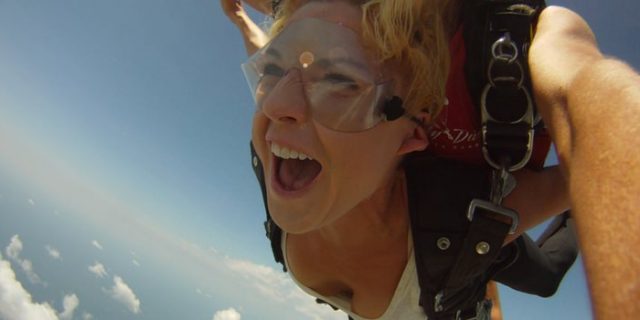How Long Does Skydiving Last?
Skydiving Information
Posted by: SCC ADMIN
9 years ago

IF YOU’RE A FIRST-TIME SKYDIVER AND YOU’VE BEEN HEARING YOUR FRIENDS’ JUMP STORIES, WE’RE PRETTY SURE YOU’RE CONFUSED. RIGHT? HERE WE ADDRESS THE NOT-SO-STRAIGHTFORWARD ANSWER TO THE QUESTION… HOW LONG DOES SKYDIVING LAST?
When they talk about their jump, they probably talk about how the moment seemed to last forever, but at the same time went by in something like a fraction of a second.
A sport-skydiving friend of mine said it best when he put it like this: “We live longer in three seconds than some people live their entire lives.”
Of course, there’s so much more to the story. BBC broadcaster and psychology writer Claudia Hammond’s wrote a book called “Time Warped: Unlocking the Mysteries of Time Perception,” which goes deliciously into the remaining details. The book tackles the alternately baffling and encouraging science behind our brains’ relationship with our wristwatches. The material is intensely interesting and very applicable for the extreme athlete–and the first-time skydiver, too.
Linear time lies at the heart of the way we organize life. It also lies at the heart of the way we experience it, and this might be the bigger concept–because what’s within our own minds is under our own control.
According to Hammond, our memory “is never a precise duplicate of the original [but] a continuing act of creation.” Anyone who has ever recounted a jump in conversation just afterwards, then reviewed the footage to watch what appears to be an entirely different one to the jump described, can relate.
So, too, can skydivers relate to the curiously changing shape of time during the hyper-focused moments surrounding the activity — as though some experiences are being scrubbed through in super-fast-forward, while others are playing out almost frame-by-frame. It turns out that fluxes in time perception aren’t simply an athletic and personal deficiency; these mental gymnastics around the concept of time’s passage are, per Hammond, a “defining feature of how the human mind works.”
Hammond’s hypothesis is compelling in its simplicity: that the way we experience the passage of time is not an external process we’re subjected to. Instead, time as we know it is actively created by our own minds. It isn’t reliable and it is certainly not objective. Neuroscientists and psychologists call this “mind time,” and Hammond describes how we as humans — and, by extension, we as extreme athletes — can shape it and use it to our own benefit.
Predictably, the section of the book that held my attention most closely was that in which Hammond delved into the intersection of “mind time” and extreme sports. She taps a study which quizzed first-time skydivers about the time they themselves spent in freefall in comparison to the time others spent in freefall. Well, any experienced airsports athlete can predict the result of that experiment. Every time, the interviewee estimated their own free fall to be longer than their peers’. The actual, “clock” times were, of course, almost precisely the same. It turns out that, in a physiological sense, that phenomenon is attributable to the biofeedback engendered by the body’s fear response. The “slow-motion car crash” isn’t a myth–it’s a cognitive reality.
The moral of the story is a beautiful and brilliant one: if we can start to see “mind time” as flexible and ourselves as active participants in our experience of it, Hammond suggests that we can stay in flight just a little longer in our own minds. This is a deeply appealing thought for athletes who practice a sport that often requires us to fold fabric for fifteen minutes in order to enjoy 90 seconds of freefall.
“Time Warped” is a profoundly conceptual but still, somehow, practical book. It addresses the way our internal clocks dictate our lives and the ways in which mindfulness works as a tool to master that internal clock.
One of the book’s most beautiful passages sums it up brilliantly:
“We will never have total control over this extraordinary dimension. Time will warp and confuse and baffle and entertain however much we learn about its capacities. But the more we learn, the more we can shape it to our will and destiny. We can slow it down or speed it up. We can hold on to the past more securely and predict the future more accurately. Mental time-travel is one of the greatest gifts of the mind. It makes us human, and it makes us special.”
Join us for a skydive near Myrtle Beach, and we’ll show you just what she means.





